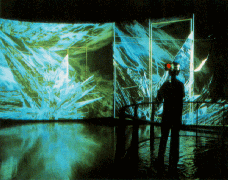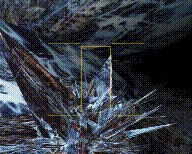
PERCEPTUAL ARENA PROJECT

The complexity of the arena world results out of the total interrelation of all it's factors which in the end all depend on the users input data.
The factors are:
 the users view onto the space
the users view onto the space
 the users movement in the space
the users movement in the space
 a history of movement and view
a history of movement and view
 a virtual sensor in the
field of view which applies history onto the space
a virtual sensor in the
field of view which applies history onto the space
 the total access with a data glove
onto the space through the field of view
the total access with a data glove
onto the space through the field of view
 the virtual clay which is object and
result of all this factors.
the virtual clay which is object and
result of all this factors.
 (photo: Kai Frike)
(photo: Kai Frike)
In the arena world the individual view point is the center of all interaction. From this center the viewed space becomes affected by the interfaces virtual sensor and glove. To become complex, the environment has to be perceived.
VIRTUAL SENSOR:
To view already existing polygons triggers their structural change. The
interface between things in space and personal view is a virtual sensor.
It slides over the world with the view and activates the perceived.
The virtual sensor is an active space volume (3D-culling) in the field of
view and works with relative scales which are complexly interrelated to each other.
The scales are fed with parameters of the viewing history. The
sensor volume grows and shrinks from the user's 2D-field of view into the
3D-space and becomes more or less intense. How long a structure stays in
the field of vision determines its attraction to the sensor. The more
radical the attraction is, the more extreme it changes. The maximum sensor
size is the entire viewed space.VIRTUAL CLAY:
 The more intense the view on a part of the space is, the more energetic the
virtual sensor gets in this area and causes the structures to unfold.
Activated polygons and sound grains start to move, they organize into clusters,
get connected to each other or cell into multiples. The resulting virtual clay
textures the space like a not symbolic primary soup of virtual material.
Complexity, quantity, dimensions, densities and spread are abstractions of the
user activity. These self-created views are infinite, permanently changing and
never repeating.
The more intense the view on a part of the space is, the more energetic the
virtual sensor gets in this area and causes the structures to unfold.
Activated polygons and sound grains start to move, they organize into clusters,
get connected to each other or cell into multiples. The resulting virtual clay
textures the space like a not symbolic primary soup of virtual material.
Complexity, quantity, dimensions, densities and spread are abstractions of the
user activity. These self-created views are infinite, permanently changing and
never repeating.TOTAL ACCESS:
The data glove is also bound to the 2D-field of view and has
three culling zones.
The active space volume of the glove extends in the z-direction
dependent on the history. The data glove grasps the virtual clay and extends
it towards the viewpoint. This causes immediate and radical transformations
of the structures, but it is also recorded as irregularity.
The more irregularity irritates the glove history, the less balanced the proportion of created and destroyed polygons becomes, finally leading to a total deletion of the world.
Co-produced 1993 at Canon Artlab, Tokyo
Supported by the Staedelschule, Institut fuer Neue Medien, Frankfurt